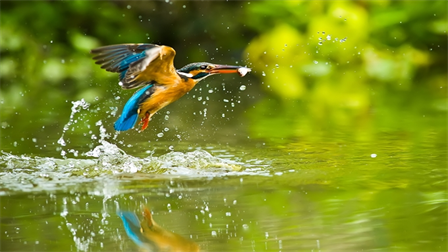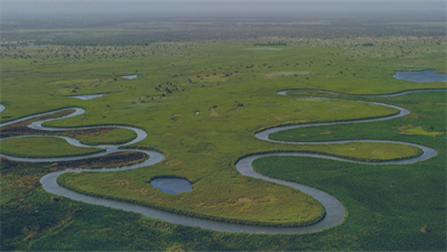Preserving Forests with Superfruits: AJE’s Blueprint for Change
Start Reading

1. Company at a Glance
In this case study, we explore how Grupo AJE, a Peruvian beverage leader, embedded nature-based solutions into its operations to drive business success, empower Amazonian communities, and set a new standard for biodiversity conservation. Through sustainable sourcing, strategic partnerships, and initiatives like AMARUMAYU, Grupo AJE proves that preserving nature isn’t just an ethical choice—it’s a strategic advantage.
Beverages
Industry
1988
Founded
Peru & Spain
Headquarters
+ 10,000
Number of Employees
Over 20 countries in Latin America, Africa and Asia
Global Presence
2. The Challenge
Grupo AJE implemented this good practice to align its business growth with sustainability and respond to the increasing demand for responsible products and services. The company identified an opportunity to transform obstacles—such as limited access to formal markets, social exclusion, or environmental degradation—into a competitive advantage, creating value not only for shareholders but also for local communities and ecosystems.
3. The Action
Developing a Sustainable Beverage Line as a Strategic Decision
The company decided to launch a beverage line based on native superfruits in 2017, making sustainability a core business driver from the start. Since then, the line has grown steadily: it began with sustainable value chains for Aguaje and Camu Camu, expanded in 2019 with the creation of the AMARUMAYU business unit and the launch of natural juices, incorporated new products such as Aguaymanto and Açaí in 2020, and introduced innovative BioShots in 2022. This consistent growth demonstrates the scalability of the model and its capacity to generate both economic and environmental value.
Strengthening the Value Chain Through Sustainable Sourcing
Fair trade agreements and sustainable harvesting practices were established with local communities to guarantee resource conservation and ensure stable income generation. Training programs and technical assistance improved harvesting techniques, strengthened local capacities and secured the consistent quality of raw materials for the beverage line.
Building Trust and Organizing Community Participation
To formalize and scale the initiative, the company promoted the creation of community associations. This facilitated transparent and organized collection processes, encouraged active participation of women and men and fostered long-term trust between the company and local producers.
Forging Strategic Alliances to Scale Impact
Partnerships with public institutions and international organizations were essential to overcome structural barriers and expand the initiative. Collaboration with entities such as the Ministries of Environment in Peru and Colombia, environmental NGOs like Wildlife Conservation Society, and programs supported by the British Government like Partnerships for Forestprovided technical expertise, conservation support and international visibility. These alliances strengthened ecosystem protection and enhanced the project’s credibility as a reference in sustainable business practices.
Innovating With a Clear Sustainability Value Proposition
The beverage line was positioned as a product delivering triple value: good for health, good for communities and good for the environment. This strong sustainability proposition not only met the expectations of conscious consumers but also enhanced the company’s visibility and reputation in global forums. The initiative has been showcased at major international platforms such as Food and Agriculture Organization of the United Nations (FAO) events and the COP26, COP27, COP28 and COP16 biodiversity summit.
4. Overcoming Barriers
Economic informality: More than 90% of the local economy operated outside formal structures, making it difficult to secure stable agreements. This was addressed by establishing fair trade contracts and creating local associations, which ensured transparency and encouraged broader community participation.
Logistical constraints: Remote locations, poor infrastructure and high transportation costs increased operational complexity. The company collaborated with international cooperation agencies and public institutions to improve logistics and secure financial and technical support, enabling expansion into new areas.
Building trust with communities: Initial skepticism due to social exclusion and lack of prior formal economic activities was overcome through training, provision of equipment and the inclusion of both men and women, fostering long-term collaboration and stronger local partnerships.
5. Impacts & Results
Environmental conservation
More than 4.5 million hectares of primary forest were supported through sustainable harvesting practices, contributing to the protection of 11 native species and biodiversity.
Community empowerment
Over 400 families from 25 communities were integrated into formal economic activities, receiving stable income and professional training.
Strengthening local economies
More than 2.4 million kilograms of native superfruits were purchased, generating continuous economic opportunities for local producers.
Market positioning
The beverage line became a reference for sustainable products, differentiating the company in a competitive market and aligning brand reputation with responsible consumption trends.
Employee engagement
The initiative increased employees’ sense of pride and belonging, reinforcing the company’s internal commitment to sustainability.
6. Key Lessons Learned
Building strong alliances is possible with a common goal: Constructive partnerships with public institutions, NGOs and international cooperation agencies were essential to create and sustain the bio-business, proving that collaboration works when the shared objective is as relevant as biodiversity preservation.
Trust-based relationships with local communities are critical: Moving beyond the traditional supplier–client model and fostering mutual support strengthens long-term collaboration. Identifying and working with local leaders who believe in the project is key to securing strategic allies.
Local leadership ensures sustainability: Engaging committed local leaders as permanent allies facilitates community participation and strengthens the project’s continuity over time.
Internal motivation drives success: A motivated workforce aligned with the project’s mission
guarantees employee commitment and reinforces the company’s sustainability culture.
"We are already replicating this model in other countries where we operate, making forest conservation a reality and improving the economy of the communities we work with, thus achieving a bio-business that is profitable for everyone."
Alberto Suárez, Manager of AMARUMAYU, Grupo AJE
7. Resources
To know more about the initiative, watch this video: Cadena de Valor
Recommended UN Global Compact resources available to support your journey:
Disclaimer: This case example is intended strictly for learning purposes and does not constitute an endorsement of the individual companies by the UN Global Compact.


